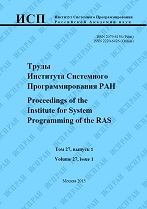|
Link-time optimization speedup
K. Dolgorukova, S. Arishin
Institute for System Programming of the Russian Academy of Sciences
Abstract:
This paper proposes the two different approaches to speed-up program build: making link-time optimization work in parallel and lightweight optimization approach. The former technique is achieved by scaling LTO system. The latter makes link to work faster because of using summaries to manage some of interprocedural optimization passes instead of full IR code in memory. The problem of horizontal LTO system scaling leads to the problem of partition of the large task to several subtasks that can be performed concurrently. The problem is complicated by the compiler pipeline model: interprocedural optimization passes works consequentially and depends on previous performed ones. That means we can divide just data on which passes works, not passes themselves. We need to divide IR code to sub-independent parts and run LTO on them in parallel. We use program call graph analysis to divide a program to parts. Therefore, our goal is to divide call graph that is one of NP-compete problems. Nevertheless, the choice of the dividing algorithm strongly depends on properties of divided graph. The main goal of our investigation is to find lightweight graph partition algorithm that works efficiently on call graphs of real programs and that does not spoil LTO performance achievements after optimizing code pieces separately. This paper proposes new graph partition algorithm for program call graphs, results of comparing this one with two other methods on SPEC CPU2000 benchmark and implementation of the algorithm in scalable LLVM-based LTO system. The implementation of this approach in LTO system shows 31% link speedup and 3% of performance degradation for 4 threads. The lightweight optimization shows 0,5% speedup for single run in lazy code loading mode.
Keywords:
compilers, link-time optimization, scalability, graph division, graph clustering.
Citation:
K. Dolgorukova, S. Arishin, “Link-time optimization speedup”, Proceedings of ISP RAS, 28:5 (2016), 175–198
Linking options:
https://www.mathnet.ru/eng/tisp75 https://www.mathnet.ru/eng/tisp/v28/i5/p175
|

| Statistics & downloads: |
| Abstract page: | 148 | | Full-text PDF : | 129 | | References: | 31 |
|




 Contact us:
Contact us: Terms of Use
Terms of Use
 Registration to the website
Registration to the website Logotypes
Logotypes








 Citation in format
Citation in format 